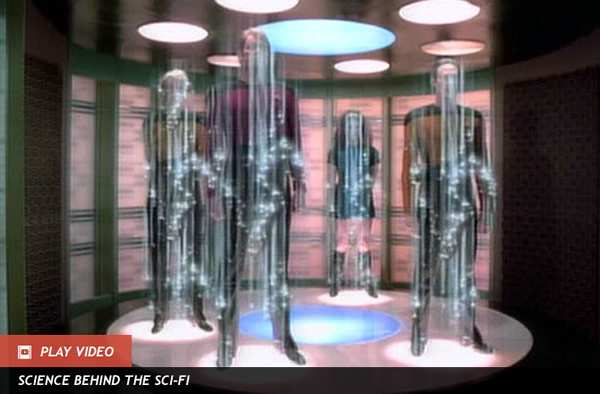Beam Me Up, Scotty? That Might Take Some Time
Beam Me Up, Scotty? That Might Take Some Time
Ah, the teleporter; a fantastic device for beaming people around space at the speed of light. Not only is this mode of transportation useful for keeping Star Trek episodes to within their 60 minute timeslot (keeping boarding, flying, atmospheric reentry, landing, un-boarding from shuttlecraft to a minimum), it could revolutionize space travel in the real world — no more rockets! Just beam people into orbit!
Alas, apart from a tiny handful of experiments on entangled photons, teleportation is, in a practical sense, pure science fiction. But let’s just assume that, for argument’s sake, the technologies to turn a human body into pure data were to be invented in the future. How long would it take to transfer all that data from Point A to Point B?
A group of physics students at the University of Leicester have asked that same question and decided to do the math. Needless to say, their results were as astronomical as the technology is improbable (by today’s technological standards in any case).
“We employed several approximations to determine the amount of data required in bits to fully store a human genetic code and neural information, and the signal to noise ratio of typical signalling equipment,” said physics masters student David Starkey. “Our results indicate the time scales to complete a full teleport of an individual are a little too lengthy at this time. Current means of travel remain more feasible.”
But what does “too lengthy” really mean? More than a second? A minute? An hour? How long is the beaming “standard” anyway? According to Star Trek (and other sci-fi shows that enjoy the use of this spacetime shortcut), the time from “beam me up, Scotty!” to rematerialization on the USS Enterprise’s transporter platform shouldn’t be longer than a few seconds. But really, how long would it take?
The students concluded that it would take 4.5×1015 years from dematerialization to rematerialization. That’s 4,500,000,000,000,000 (4.5 quadrillion) years. Or 350,000 times the age of the Universe! Um, quite a while then.
What’s with this inconvenient lag?
It’s all down to bandwidth, according to the researchers, and it sounds like human teleportation is the “dial-up Internet” of space travel.
They calculate that if we had the technology to convert an entire person into pure data — including the traveler’s brain, thoughts, memories, not to mention their entire physical structure — 2.6×1042 (that’s 2.6 times one followed by 42 zeroes) bits would need to be transmitted. Assuming a bandwidth of 29.5 to 30 gigahertz, it would take 350,000 times the length of time from the birth of the Universe to today to transmit one unit of human.
Undoubtedly there will be critics of this research, pointing out that transformative tech will slash this number to something more manageable by some hypothetical supercivilization of the future. And besides, if we had the ability to turn the body into pure data, transferring that data would likely be a piece of cake.
But for now, forget dreams of teleporting down to a Class M world or messing with trans-warp beaming… unless you’re watching Star Trek that is.
Captain Kirk: You ready, Bones?
Dr. McCoy: No. I signed aboard this ship to practice medicine, not to have my atoms scattered back and forth across space by this gadget.
Captain Kirk: You’re an old-fashioned boy, McCoy.
Image: The crew of the Enterprise use the transporter (ST:TNG). Credit: Paramount Pictures(Jul 31, 2013 06:34 PM ET // by Ian O'Neill)












